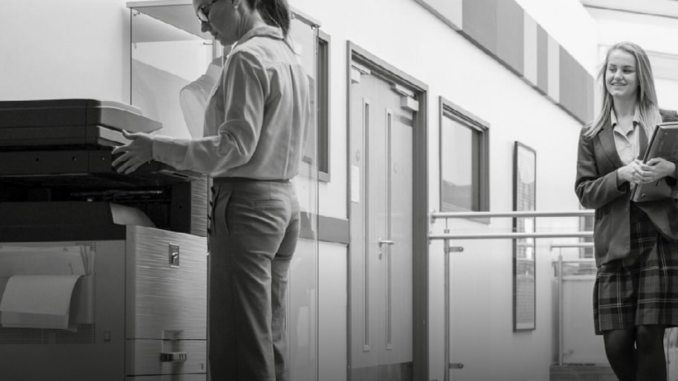
In the second of our series on managed print solutions we look at MPS in education, and how requirements have changed post-pandemic
Hard copy printing remains a key function in schools, for both teachers creating classroom resources and those in school business support who still need to print many documents and file them securely.
The COVID-19 pandemic, and the restrictions it imposed – as well as ongoing staff absence and retention pressures in schools – have meant that managing print admin has become stretched.
Dealers have an opportunity to work with school customers to ensure that their managed print services remain fit-for-purpose.
This is crucial as the challenges of the past two years have increased school reliance on print as a service. “As schools have recognised the freedom that standardising printer consumables procurement and maintenance brings, MPS has increased its reputation as a more optimised solution for schools,” says Richard Wells, head of office print sales at Epson UK&I.
Richard believes that, in the next 18 months, it is likely that demand for in-class desktop printing and workgroup printer hubs will increase as different education settings strive to accommodate more stabilised student attendance rates – and there’s a green angle too.
“Increasing societal pressures to be greener will also mean that sustainability will also continue to increase as a priority for teachers, students, parents and procurement frameworks. This has raised more questions among the education community around how they can ensure MPS is aligning with these green priorities.”
Cameron Mitchell, business unit leader (Partner Channel) at Konica Minolta Business Solutions (UK) Ltd, agrees that sustainability is a key driving force within the public sector and that this is driving business change. “Solutions and systems that increase productivity, decrease inefficiencies, and promote a better and more flexible working environment are key to achieving these goals,” he says. “Hybrid working and learning have been a major factor to evolve rapidly from the COVID pandemic era.”
DIGITAL TRANSFORMATION
Indeed, in common with many other sectors, working practices in education are changing, post-pandemic, especially among administrative and business support staff, where increased demand for flexible working has seen an increase in the assigned budget for IT solutions.
Digital transformation has become more of a priority for schools, whether they are working remotely or in school buildings.
“Digitally transforming key processes offers schools the infrastructure to deploy education technology that can help teachers transform how they teach and improve how students learn, while also improving student and parent engagement from anywhere and at any time,” says Cameron.
“Digitising documents can quickly unlock a range of print-cost savings and improve productivity. Digitally capturing all kinds of documentation – whether for the business element or student course work – enables the conversion of all kinds of printed materials into convenient and flexible PDFs that can then be supplied via the school website and digital dropbox, or by attaching to emails. “Ultimately, education customers are looking to improve automation, control costs and reduce waste around document flow and print by rationalising traditional print and fleet, which will assist in minimising the impact of rising energy and economical costs,” says Cameron.
Savvy dealers will be looking to explore these requirements with school clients to provide solutions that fulfil their needs and help to improve efficiency.
“Education customers are looking to improve automation, control costs and reduce waste”
HIGHER EXPECTATIONS
Meanwhile, in further and higher education, there is a somewhat different picture. While print volumes continue to be lower compared to pre-COVID levels, Martin Fairman, group sales and marketing director at Kyocera, believes this is changing.
“Recent conversations with our university clients have revealed that most expect their print volumes to grow again with the new student intake in September,” he says.
“Across all sectors, we’ve seen an increase in scanning in the last few months, but this is often unstructured, with no process or link to back-end systems, so there’s an opportunity for dealers to make a difference there.
“Network security in further education is paramount, but less so in the general sector as networks are often managed by third parties.”
It is expected that all education institutions want to control and manage their print volumes, including having the ability to restrict or charge students for printing; this is a trend Martin expects to develop further in the next 18 months.
Another trend in HE/FE that Martin is following closely is the adoption of cloud-first strategies, with many moving towards MPS in the cloud. “The rest of the sector remains largely on-premises – but, that said, some of the larger multi-academy trusts are now moving their schools into the cloud, which is something to keep an eye on.”
He points out that, for dealers to make the most of MPS opportunities in the education sector, they need to have a presence in a procurement framework as most education institutions buy their MPS through these now.
“Environmental impact and reducing carbon footprint also now form part of all tender opportunities, so dealers must be in a strong position to address this.”
BE PREPARED
MPS continue to be as relevant as ever within the educational sector: new pressures and trends mean that dealers have opportunities to work with their customers to provide solutions that are tailored to their particular needs. Richard stresses that, in any such sales conversation, facts about the positive differences in time, energy, waste and cost between MPS and other solutions are the best decision criteria to focus on.
Sustainability is likely to grow in importance in the coming years – as it is in many other sectors.
Dealers must be prepared for this, and offer solutions that fulfil this need, if they are to secure the business – and MPS and digitalisation will be at the heart of this.


Be the first to comment